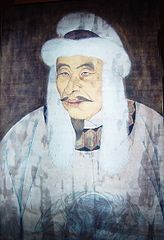Fashion in the Jurchen Jin dynasty
[2]: 85 The Jurchens, therefore, emerged from the Mohe tribes who lived south and west of the Changbai mountains and north to the Bohai kingdom.
[5]: 228 [10] This shaving hair order and adopting Jurchen clothing was however cancelled just a few months after it was stipulated as it was too difficult to enforce.
[3]: 68 The shaving hair and adoption Jurchen clothing imposition order on the Chinese was once again reinforced in 1129; however, it does not seem to have been strictly been enforced.
[12]: 92 [9]: 281 Jurchen material culture dating about 1162 were found from the coffin of the Prince of Qi, Wanyan Yan, and his wife, where Wanyan Yan and his wife were dressed in layers of clothing in the duplicate style as those worn by Lady Wenji and the warriors who accompanied her in the painting Cai Wenji returning to Han.
[3]: 61 The Prince of Qi wore earrings, drawers, padded leggings, jerkings, boots, a padded outer jacket with medallion designs at the back and front jacket; soft shoes and socks, and a small hat while his wife wore a short apron, trousers, leggings, a padded silk skirt, a robe with gold motifs, silk shoes with soft soles and turned-up toes.
[3]: 57, 61–62 The tribeswomen in the painting Cai Wenji returning to Han wear Jurchen attires consisting of leggings, skirts, aprons made of animal hide, jackets, scarves, hats made of fur or cloth; Wenji also wears Jurchen-style attire consisting of a ochre-yellow jacket, silver yunjian (a symbol of high rank), boots, and fur hat with ear flaps; the tribesmen wear typical sheng Jurchen clothing with the exception of a Han Chinese official.
[1]: 40 They could also shave their hair at the back of the head and bundled it with coloured silk; they also wore golden locks as their ornaments.
[1]: 40 They also wore clothing which were suitable to their daily lifestyles (e.g. horse riding, hunting, and herding) and weather on the Steppe, especially those made of felt, leather, and furs.
[7]: 14 In general, the Jin dynasty Jurchen clothing were similar to those worn by the Khitans in Liao, except for their preference for white colour.
Yuanlingpao with tight sleeves (closing to the left side, with pipa-shaped collar) were worn by men with leather boots and belts.
[13]: 136–137 It is also recorded in the section Carriages and Costumes of the History of Jin dynasty that Jurchen clothing were decorated with bears, deer, mountains and forest patterns.
[3] Yet despite the Han Chinese influence on Jurchens, travellers from the Southern Song dynasty who visited the former territories of the Song dynasty noted that there have been changes in the people's culture and that the Han Chinese's clothing style had also been influenced by the Jurchens in terms of adoption of items; they also noted that the only thing which had not changed much was the women's clothing style.

